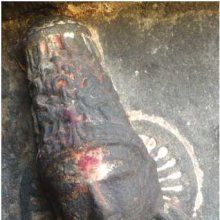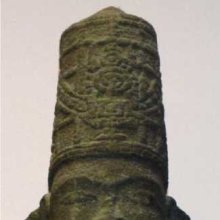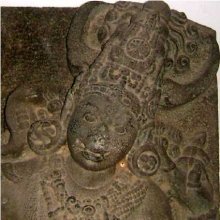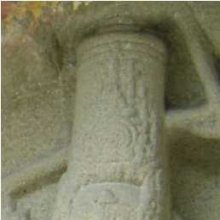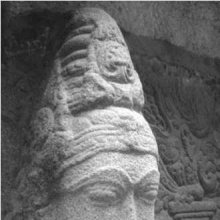Makuta, Makuṭa: 15 definitions
Introduction:
Makuta means something in Buddhism, Pali, Hinduism, Sanskrit. If you want to know the exact meaning, history, etymology or English translation of this term then check out the descriptions on this page. Add your comment or reference to a book if you want to contribute to this summary article.
Images (photo gallery)
(+18 more images available)
In Hinduism
Shaivism (Shaiva philosophy)
Source: Shodhganga: Iconographical representations of ŚivaMakuṭa (मकुट) or Makuṭāgama refers to one of the twenty-eight Siddhāntāgama: a classification of the Śaiva division of Śaivāgamas. The Śaivāgamas represent the wisdom that has come down from lord Śiva, received by Pārvatī and accepted by Viṣṇu. The Śaivāgamas are divided into four groups viz. Śaiva, Pāśupata, Soma and Lākula. Śaiva is further divided in to Dakṣiṇa, Vāma and Siddhānta (e.g., makuṭa).

Shaiva (शैव, śaiva) or Shaivism (śaivism) represents a tradition of Hinduism worshiping Shiva as the supreme being. Closely related to Shaktism, Shaiva literature includes a range of scriptures, including Tantras, while the root of this tradition may be traced back to the ancient Vedas.
Shilpashastra (iconography)
Source: Shodhganga: Vaisnava Agamas And Visnu ImagesMakuṭa (मकुट) refers to “crowns”, as defined in treatises such as the Pāñcarātra, Pādmasaṃhitā and Vaikhānasa-āgamas, extensively dealing with the technical features of temple art, iconography and architecture in Vaishnavism.

Shilpashastra (शिल्पशास्त्र, śilpaśāstra) represents the ancient Indian science (shastra) of creative arts (shilpa) such as sculpture, iconography and painting. Closely related to Vastushastra (architecture), they often share the same literature.
Shaktism (Shakta philosophy)
Source: Google Books: ManthanabhairavatantramMakuṭa (मकुट) (Cf. Mukuṭa) refers to a “crown”, according to the Tantrasadbhāva, an important Trika Tantra and a major authority for Kashmiri Trika Śaivites.—Accordingly, while describing Raudrī (Rudraśakti): “She is beautiful and has beautiful breasts. She has two arms and three eyes and is endowed with all the ornaments. She is adorned with matted hair and a crown [i.e., jaṭā-makuṭa maṇḍitā]. She holds a skull in her left hand that is filled with nectar. Adorned with necklace and anklets, one should think of her as devoted to eating and drinking”.

Shakta (शाक्त, śākta) or Shaktism (śāktism) represents a tradition of Hinduism where the Goddess (Devi) is revered and worshipped. Shakta literature includes a range of scriptures, including various Agamas and Tantras, although its roots may be traced back to the Vedas.
In Buddhism
Tibetan Buddhism (Vajrayana or tantric Buddhism)
Source: Brill: Śaivism and the Tantric Traditions (tantric Buddhism)Makuṭa (मकुट) refers to a “crown”, according to the Nāmamantrārthāvalokinī by Vilāsavajra, which is a commentary on the Nāmasaṃgīti.—Accordingly, [while describing Mahāvairocana]—“And then [the Sādhaka should visualise] Mahāvairocana on the principal seat, generated by means of the syllable āḥ. [...] He is white in colour because he has the Dharma-Sphere as his nature. He has braids of hair [stacked up on his head] as a crown (jaṭā-makuṭa-upeta) and is unadorned because he is one whose mind is tranquil. Since he has both wisdom and means as his nature he makes the bodhyagrī (“highest awakening”) hand gesture”.
Source: OSU Press: Cakrasamvara SamadhiMakuṭa (मकुट) refers to a “crown”, according to the Ṭīkā Pot Worship [i.e., Kalaśapūjā] ritual often performed in combination with the Cakrasaṃvara Samādhi, which refers to the primary pūjā and sādhanā practice of Newah Mahāyāna-Vajrayāna Buddhists in Nepal.—Accordingly, “Oṃ Jambhanī, Stambhanī, Mohanī, and Ākarṣaṇī, All works (are) thus a success, by your power of infatuation, Standing in an archer’s pose, with a beautiful flaming crown (makuṭa—kalyāṇamakuṭo jvalam), Ālī and Kālī united, Śrī Saṃvara, the supreme being”.

Tibetan Buddhism includes schools such as Nyingma, Kadampa, Kagyu and Gelug. Their primary canon of literature is divided in two broad categories: The Kangyur, which consists of Buddha’s words, and the Tengyur, which includes commentaries from various sources. Esotericism and tantra techniques (vajrayāna) are collected indepently.
Languages of India and abroad
Pali-English dictionary
Source: BuddhaSasana: Concise Pali-English Dictionarymakuṭa : (m.; nt.) crest; crown; a coronet.
Source: Sutta: The Pali Text Society's Pali-English DictionaryMakuṭa, (f.) (cp. BSk. makuṭa Divy 411) a crest Abhp 283 (kirīṭa+, i.e. adornment). (Page 511)

Pali is the language of the Tipiṭaka, which is the sacred canon of Theravāda Buddhism and contains much of the Buddha’s speech. Closeley related to Sanskrit, both languages are used interchangeably between religions.
Sanskrit dictionary
Source: DDSA: The practical Sanskrit-English dictionaryMakuṭa (मकुट).—A crown; cf. मुकुट (mukuṭa); Mahābhārata (Bombay) 3.
Derivable forms: makuṭam (मकुटम्).
Source: Cologne Digital Sanskrit Dictionaries: Edgerton Buddhist Hybrid Sanskrit DictionaryMakuṭa (मकुट).—nt. or m. (= Pali and Sanskrit Lex. id.; one doubtful Sanskrit occurrence, Schmidt, Nachträge; Sanskrit muk°), diadem, crown: Mahāvastu i.129.7 (verse, read with mss. śiraṃ… sa-makuṭaṃ; Senart's em. impossible in meter and im- plausible in sense); Mahāvastu i.153.1 = ii.29.16 (verse; same verse i.226.13 muk°); ii.316.11 (verse, read with one ms. śīryanto, or °ta, mahyaṃ makuṭo…); iii.178.16, 19 (°ṭam, n. sg.); [Page413-1b+ 12] Divyāvadāna 411.12 (°ṭaṃ dattam, n. sg.); (Ārya-)Mañjuśrīmūlakalpa 63.2 etc.; of flowers, gandha-makuṭā Mahāvastu ii.463.3, and °ṭāni 4 (prose), fragrant crowns (of flowers).
Source: Cologne Digital Sanskrit Dictionaries: Shabda-Sagara Sanskrit-English DictionaryMakuṭa (मकुट).—n.
(-ṭaṃ) A crest, a head-dress, a crown, a tiara. E. maki to adorn, aff. uṭa form irr.
Source: Cologne Digital Sanskrit Dictionaries: Monier-Williams Sanskrit-English DictionaryMakuṭa (मकुट):—n. a crest (= mukuṭa), [Divyāvadāna]
Source: Cologne Digital Sanskrit Dictionaries: Yates Sanskrit-English DictionaryMakuṭa (मकुट):—(ṭaṃ) 1. n. A crest, a crown.
[Sanskrit to German]
Sanskrit, also spelled संस्कृतम् (saṃskṛtam), is an ancient language of India commonly seen as the grandmother of the Indo-European language family (even English!). Closely allied with Prakrit and Pali, Sanskrit is more exhaustive in both grammar and terms and has the most extensive collection of literature in the world, greatly surpassing its sister-languages Greek and Latin.
Kannada-English dictionary
Source: Alar: Kannada-English corpusMakuṭa (ಮಕುಟ):—[noun] = ಮಗುಟ [maguta]1.
--- OR ---
Makuṭa (ಮಕುಟ):—
1) [noun] a headdress of gold, stud with jewels, worn by a king, as an emblem of sovereignty; a crown; a diadem.
2) [noun] (fig.) that which is a symbol of excellence, superiority, surpassing goodness, etc.
Kannada is a Dravidian language (as opposed to the Indo-European language family) mainly spoken in the southwestern region of India.
See also (Relevant definitions)
Starts with (+6): Makuta Cetiya, Makuta gambewa, Makutabaddha, Makutabandha, Makutabandhana, Makutabhamga, Makutadanti, Makutadhara, Makutagama, Makutam, Makutamandita, Makutamani, Makutamutta Sala, Makutancul, Makutarakam, Makutaramakkiri, Makutaratna, Makutarekai, Makutasvara, Makutatipati.
Ends with (+22): Anabhibhutamakuta, Ardhamakuta, Ashmakuta, Avabhasamakuta, Bhasmakuta, Bodhimandamakuta, Brahmakuta, Calamakuta, Chalamakuta, Chitramakuta, Citramakuta, Devamakuta, Dharmadhatupratibhasamanimakuta, Dharmakuta, Digvairocanamakuta, Digvairochanamakuta, Gamakuta, Gramakuta, Haimakuta, Hemakuta.
Full-text (+56): Panamakutam, Shrimakuta, Makutabandhana, Makutagama, Makuta gambewa, Mukuta, Ratnamukuta, Makutarakam, Makutaramakkiri, Ardhamakuta, Manimakutam, Jata, Makutarekai, Karkataka, Makutottara, Pattavarttanar, Annaprashana, Vivaha, Caula, Maheshvari.
Relevant text
Search found 19 books and stories containing Makuta, Makuṭa; (plurals include: Makutas, Makuṭas). You can also click to the full overview containing English textual excerpts. Below are direct links for the most relevant articles:
Head-Gears in Hindu Art < [March 1937]
'Tiger' Varadachar < [March 1937]
Architecture And Temple Construction < [January 1958]
Pallava period (Social and Cultural History) (by S. Krishnamurthy)
Head-dress of Women (a): Karanda-makuta < [Chapter 4 - Material Culture of the People]
Crowns for Men (b): Karanda-makuta < [Chapter 4 - Material Culture of the People]
Head-dress of Men (Crowns) < [Chapter 4 - Material Culture of the People]
Temples of Munnur (Historical Study) (by R. Muthuraman)
Images of Dvarapalas < [Chapter 5]
Images of the Saptamatrikas < [Chapter 5]
Introduction: The Sculpture Art of the Munnur Temples < [Chapter 5]
Manasara (English translation) (by Prasanna Kumar Acharya)
Chapter 49 - The crowns (mauli) and coronation (abhiṣeka)
Chapter 51 - The Triad (trimūrti: Brahmā, Viṣṇu, and Maheśa/Śiva)
Cosmetics, Costumes and Ornaments in Ancient India (by Remadevi. O.)
2.1. Head Ornaments (b): Mukuṭa or Makuṭa < [Chapter 3 - Ornaments]
Later Chola Temples (by S. R. Balasubrahmanyam)
Temples in Nidur < [Chapter II - Temples of Kulottunga I’s Time]
Temples in Tribhuvanam < [Chapter XII - Temples of Kulottunga III’s Time]
Temples in Melakkadambur < [Chapter II - Temples of Kulottunga I’s Time]
